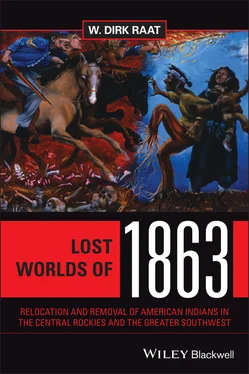Like their Bannock and Shoshone cousins, the aboriginal history of the Paiutes is very incomplete. Because of their linguistic affinity, they may have had a similar past, including thousands of years in the deserts of the Great Basin, or shared a history of a rapid expansion from Death Valley to the Great Plains. It is believed that Southern Paiutes moved into the southwestern region of what is now the United States around 1000 C.E. It is known that Northern Paiute speakers from eastern Oregon had contact with Numic speakers near the Snake River in the early 1700s, and it was this contact that introduced them to horse transportation. 27
Although direct contact with Europeans was rare for the Northern Paiutes, Southern Paiutes encountered the Catholic Padres Silvestre Vélez de Escalante and Francisco Domínguez in 1776 when the fathers were seeking to find an overland route from New Mexico to California. Later the arrival of Spanish, Mexican, and American explorers facilitated the slave trade that brought new suffering to the Southern Paiutes. Navajo and Ute Indians exchanged their Paiute slaves for horses, guns, and ammunition from New Mexican and American traders.
Once they adopted horse culture, Northern Paiutes developed mounted “bands” that, in conjunction with their Northern Shoshone cousins, traveled beyond the Rocky Mountains to the Plains in search of buffalo. But even in the early nineteenth century most Paiute groups were seemingly without horses if the testimony of Meriwether Lewis and William Clark or Hudson’s Bay trapper Peter Skene Ogden can be trusted. Throughout the 1830s historical documents seem to indicate that most Northern Paiutes were carrying on a traditional subsistence culture without the aid of horses or firearms. 28
The period of expansion of the use of the horse and the rise of raiding parties in the 1850s coincided with the discovery of gold at Sutter’s Fort and the establishment of the California Trail that channeled emigrants through the heartland of Nevada’s Paiute population. This mass migration impacted the subsistence patterns of the natives, with seed plants, fuel sources, water holes, and large game being virtually eliminated on both sides of the trail. 29
By 1859 gold and silver had been discovered in the Virginia Range in western Nevada. The Comstock Lode not only produced a mass of silver and gold that created millions of dollars for their San Francisco owners, but led to the founding of the twin mining towns of Virginia City and Gold Hill and the arrival of hundreds of settlers who were involved in mining and ranching. 30At around the same time Mormons arriving from northern Utah began settling the best lands of the Southern Paiutes, founding Las Vegas in 1857 and Saint George in 1861. Meanwhile, intent on establishing an outpost of faith in the San Bernardino area, Mormon miners discovered gold and silver in the mid- and late-1850s in the Amargosa Valley and Panamint Mountains at the southern edge of Owens Valley. 31
In 1861 cattlemen from the San Joaquin Valley and the Tejon country of southern California started driving their herds through Walker Pass and Owens Valley to the booming markets of the new mining centers in Nevada. Eventually, they established permanent ranches in Owens Valley and the grazing of their cattle destroyed the native plants that were an essential part of the Paiute diet. Rather than face starvation, the Paiutes began to prey on the ranchers’ cattle, and hostilities between Indians and whites started. 32The era of confrontation had begun.
Concerning Anglo-American activity, the Owens Valley story begins (like most narratives of the mid-nineteenth century West), with the discovery of gold in northern California in 1848 and the migration of argonauts to the gold fields that next year. After California obtained statehood and territories created for Utah and New Mexico in 1850, the West was divided into five military departments with fewer than 13,000 troops to garrison a frontier of more than a million square miles. Militia and local volunteers were necessary to support the national military effort. After Fort Sumter fell in 1861, most of the public believed that federal troops should protect the Pacific coast and that the Indian conflicts of the western interior should be a secondary priority. Just as the pre-Civil War period saw gold seekers moving from California to the mining fields of the West and Southwest, so too did a California Indian policy move eastward from the Pacific coast to the interior mountains and deserts of the Greater Southwest.
During the second season of gold mining, the summer of 1849, prospectors started spreading throughout the Sierra Nevada Range. Those that went south from the Sacramento and American Rivers usually stopped off at Stockton for supplies and equipment. Before long Stockton had become an important trading center. Argonauts from Stockton might travel 110 miles to the diggings on the Stanislaus River, or travel another 50 miles to the Merced River. Another 20 miles would take them to the Mariposa stream. If the adventurer went up the Merced he could look for gold in Yosemite. After all, no less a person than John C. Fremont had found gold at his Mariposa ranch, and if placer mining could be successful at Mariposa, the “mother vein” might be in the mountains of Yosemite.
The more daring of souls could hike 366 miles all the way up the San Joaquin River to what is known today as the John Meir Wilderness Area south of Yosemite. In one year, 1849, the San Joaquin Valley increased by more than 80,000 individuals. The old 1820 El Camino Viejo road, that connected the Los Angeles Basin with San Francisco along the west side of the San Joaquin Valley, would be used by prospectors, merchants, and settlers alike. All of this was not good news for the indigenous population.
Generally speaking, where prospectors go ranchers and farmers will follow, along with merchants and bankers. The only real problem was that Indians always seemed to be using the best lands. Ergo, white Americans had to resolve the problem by removing the Indian, either through the actions of miners’ militias, vigilante groups, citizen posses, or federal troops. Enter the protagonist of the Mariposa Indian War, 1851–1853, a wild white fellow with at least five Indian wives known, ironically enough for an Indian fighter, as James D. Savage. 33
Although at first Savage was doing the tedious work of panning for gold on the Merced River, by 1850 he quickly abandoned that activity by setting up a trading post outside of Mariposa followed by another on the Fresno River. When an Indian raid destroyed his Fresno operation, the governor quickly authorized Savage “Major” of the “Mariposa Battalion,” comprised of three companies of volunteers. A few “Yosemites” (Awanis or Ahwahnees) were killed, some were taken hostage, and Teneiya (or Tenaya), headman of the Awanis, was captured. Overall, the Mariposa Battalion had mostly succeeded in being the most likely first group of white men to camp in Yosemite. 34
The final episode came in 1853 after two miners were killed by Indians in Yosemite. The volunteers forced Teneiya and his followers to flee Yosemite to the safety of the Mono Indians at the northern end of Owens Valley. That expedition failed too, but in pursuing the old chief the volunteers had opened up a new route to Owens Valley via Tuolumne Meadows and Mono Pass. And, more importantly, Yosemite was safe for mining. 35
That next year, at the urging of Edward Fitzgerald Beale, Superintendent of Indian Affairs in California, the US established an outpost at Fort Tejon in California. It was located in the southwestern corner of the San Joaquin Valley in the Tejon Canyon (known as Grapevine Canyon; La Cañada de las Uvas ) between the Tehachapi Mountains and the Los Angeles Basin to the south and the Mojave Desert to the southeast. A year earlier, in September 1853, Beale had established the Sebastian Indian Reservation 25 miles away from the Fort Tejon site, and by the time of the founding of the Fort over 2,500 Indians, mostly Chumash (the original inhabitants of Tejon Canyon), were living there. Fort Tejon itself was launched to protect travelers along El Camino Real Viejo as well as settlers from attack by discontented Californios and angry Paiutes and Mojaves. The army was also to protect reservation Indians from their white attackers. 36
Читать дальше












